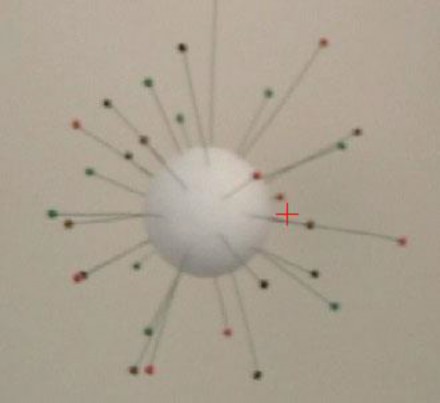< Previous | Contents | Manuals Home | Boris FX | Next >
Calibration Requirements and Fixturing
In order for motion tracking footage to be solved, the camera positions, orientations, and fields of view must be determined, independent of the “live” footage, as accurately as possible.
To do this, we will use a process based on moving-object tracking. A calibration object is moved in the field of view of all the cameras, and tracked simultaneously.
To get the most data fastest and easiest, we constructed a prop we call a “porcupine” out of a 4” Styrofoam ball, 20-gauge plant stem wires, and small 7 mm colored pom-pom balls, all obtained from a local craft shop for under $5. Lengths of wire were cut to varying lengths, stuck into the ball, and a pom-pom glued to the end using a hot glue gun. Retrospectively, it would have been cleverer to space two balls along the support wire as well, to help set up a coordinate system.

The porcupine is hung by a support wire in the location of the performer’s head, then rotated as it is recorded simultaneously from each camera. The porcupine’s colored pom-poms can be viewed virtually all the time, even as they spin around to the back, except for the occasional occlusion.
Similar fixtures can be built for larger motion capture scenarios, perhaps using dolly track to carry a wire frame. It is important that the individual trackable features on the fixture not move with respect to one another: their rigidity is required for the standard object tracking.
The path of the calibration fixture does not particularly matter.
©2024 Boris FX, Inc. — UNOFFICIAL — Converted from original PDF.
